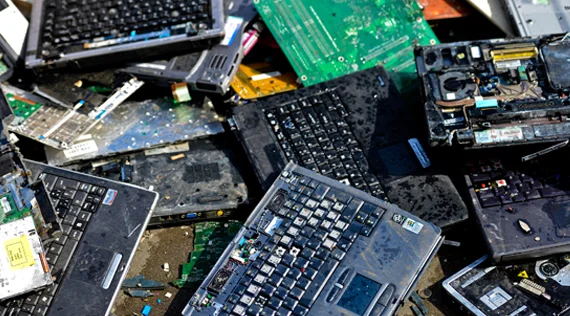
SEATTLE (Scrap Monster): Students in The Computer is a Cloud course (COM 473), conducted an electronic-waste (e-waste) drive on the Hawk Hill campus from Nov. 29 to Dec. 1, collecting almost 100 used electronic items including laptops, batteries, mobile phones, cameras, wires and cables.
Rachael Sullivan, Ph.D., assistant professor of communications, and COM 473 instructor, said she wanted her students to learn about how e-waste is recycled.
“I wanted to think about how our devices get made and then where they go when they are dead,” Sullivan said. “So basically, tracing the manufacturing process, like infrastructure, and all the things we don’t think about as communication students, but that are also part of our platform.”
Sullivan said she contacted a nonprofit electronics recycler that provides transitional employment to citizens returning from prison. PAR-Recycle Works, or People Advancing Reintegration, collects and recycles electronics at its facility on West Hunting Park Avenue in Upper North Philadelphia.
Sullivan said she wanted to support PAR-Recycle Works by collecting e-waste, and arranged for her students to visit PAR-Recycle Works.
“They got to see the whole process,” Sullivan said. “We basically worked for 45 minutes [at PAR] just taking apart computers so they got to experience what it was like and just how hard it is, and also what the devices looked like inside.”
Maurice Q. Jones, general manager of PAR-Recycle Works, said he wanted to help students learn how to take apart computers so they understand what it is like to be an employee at the organization.
“It isn’t that hard of a job, but it is an entry level position that can be the catalyst to one’s employment,” Jones wrote in response to written questions from The Hawk. “The hope is that they can see the value in the materials as well as those who we serve.”
The Environmental Protection Agency (EPA) estimates that about 38.5% of the approximately 2.7 million tons of consumer electronics goods generated as municipal solid waste in 2018, was recycled.
Students from the class were divided into groups of logistics and planning, social media promotions and presentation of the results of the drive. Sullivan said she let the students have complete control of the set up of the drive and locations of the bins.
“Sometimes electronic-waste is recycled properly, and sometimes it’s not,” Sullivan said. “So that was why I wanted to talk about this in the class.”
Charlotte Ashley ’25, a student in COM 473, did social media promotions for the project and said she spread the word through different media platforms such as Instagram to draw in a larger audience. The students chose specific locations to place the bins in buildings such as Merion Hall, Bronstein Hall and Campion Student Center.
“We wanted to choose places where it was easy access for people in the group to go pick it up,” Ashley said. “Like in Bronstein, we chose the communications office and then we also chose other busy areas of traffic.”
The goal of the drive was to spread the word of recycling e-waste, in addition to supporting PAR-Recycle Works, said Allyson Snyder ’25, another COM 473 student. The students collected around 35 cell phones, 30 laptops, 4 televisions, an abundance of cords and many other electronic devices.
“We’re not only trying to help bring awareness to e-waste and allow people to properly recycle it, but we’re also trying to support PAR and make students and faculty more aware of their mission and how they give back to the community,” Snyder said.
Courtesy: www.sjuhawknews.com
| Copper Scrap View All | |
| Alternator | 0.32 (0.01) |
| #1 Copper Bare Bright | 3.77 (0.07) |
| Aluminum Scrap View All | |
| 356 Aluminum Wheels (Clean) | 0.73 (0.02) |
| 6061 Extrusions | 0.64 (0.02) |
| Steel Scrap View All | |
| #1 Bundle | 475.00 (0) |
| #1 Busheling | 495.00 (0) |
| Electronics Scrap View All | |